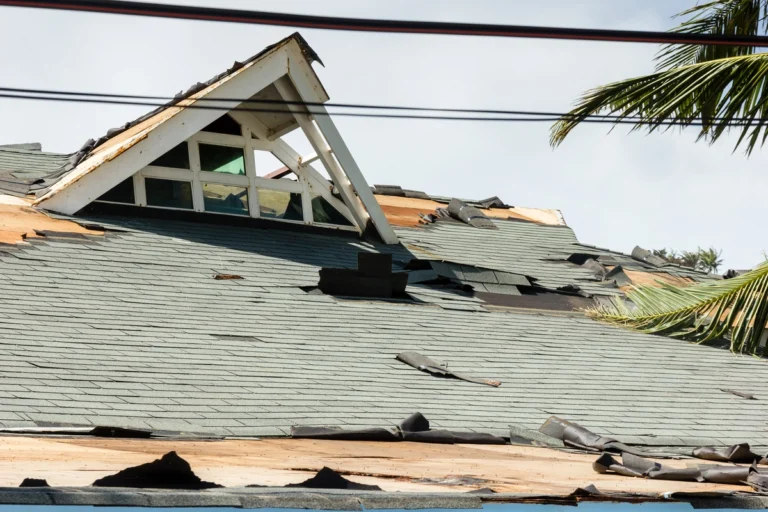When you need a roof replacement asap, you don’t always have the time to save up for it.
If your roof is in bad shape, you likely need an immediate replacement but that also means figuring out a way to pay for it. Of course, roof replacement costs vary depending on where you live, the extent of repairs, and your chosen contractor.
Fortunately, you have several roof financing options available to suit your budget and situation. Below we’ll discuss some of the best options to help you finance your new roof.
Insurance

First, reach out to your insurance company for roof repair or replacement. Your homeowners’ insurance policy should cover roofing so long as the damage is from an act of nature or an unpreventable accident. You’ll need to check with your insurance company and your documentation to see what your policy covers.
A claims adjustor will inspect the damage and decide if you’re eligible for coverage. You’ll have to meet your deductible if you haven’t already. Deductibles vary based on several factors, such as where you live.
Home Equity Loan
A home equity loan, also called a second mortgage, is based on the amount of equity in your home. To find out how much equity your home has built up, you’ll subtract your remaining mortgage balance from the current market value of your house. The difference is your equity, and you’ll likely have more equity if you’ve had your property for several years.
You can usually borrow up to 80 or 85% of your home’s equity. If you’re approved, you’ll receive a lump sum and pay monthly notes with principal and interest at a fixed rate. Home equity loans can be a good option, provided your home doesn’t decrease in value.
Home Equity Line of Credit (HELOC)
A home equity line of credit also lets you borrow against your home’s equity. However, rather than getting a lump sum, You’ll have a set line of credit based on your home’s equity. You can borrow as you need to, and as you repay it, you’ll be able to borrow again.
HELOCs have a variable interest rate, meaning you may pay more or less in interest from month to month. Some banks may allow you to convert some of it to a fixed-rate loan.
In most situations, a home equity loan is your best option. But if you have several home improvement projects you plan on doing over several months, you might want to consider a HELOC so you can pay one off and move to the next.
FHA

If you don’t have a significant amount of equity in your home, you may be eligible for an FHA loan. There are two types of FHA loans to consider.
203(k)
A 203(k) loan allows you to make improvements on a home that will increase its value. The loan may have a fixed or variable rate. You can usually borrow 110% of your home’s value after renovations or the cost of your property plus renovations.
You’ll have to pay an FHA-approved consultant, and you’ll need to pay a down payment based on your credit score.
Title 1
If your debt-to-income ratio is less than 45%, you might qualify for an FHA Title 1 loan. It’s a fixed-rate loan and must be used on improvements that make your home more livable.
Cosmetic renovations likely won’t be covered, but if your roof is damaged and leads you to be unable to live in your home, you may qualify.
Contractor Financing
In some cases, roofing companies may offer financing that would see you make monthly payments with principal and interest. You may get a lower interest rate by going directly through a roofing contractor, and you can expect fixed monthly payments.
You’ll also have the advantage of working exclusively with your contractor instead of having to navigate both a contractor and a bank.
Debt Consolidation Loan

If you have a lot of debt, it may be difficult for you to acquire financing. Debt consolidation loans can help you manage your debt and lower your interest rates. Instead of paying each lender every month, you’ll have one monthly payment to focus on.
You may then be able to free up some money for roof replacement financing. When you consolidate debt, you shouldn’t be under so much stress each month and you’ll be able to get out of debt sooner.
Personal Loan
If you don’t have enough equity in your home and don’t qualify for one of the FHA loans, you can always try a personal loan. The bank will give you money directly, making this type of roof loan less of a bureaucratic hassle. You’ll usually have a fixed interest rate and pay it off with monthly payments.
Personal loans are often dependent on the bank you choose. They’ll consider your credit score and debt-to-income ratio when deciding how much money you’ll get and what you’ll pay in interest. Choosing an institution where you have a bank account can help with your application.
Credit Card
If you’re struggling to get one of the other roof financing options, you could consider a credit card. You won’t even need to get a new card if you already have one with a high enough credit limit. If not, you’ll need to apply for one or request a higher limit from your current card.
Most credit card companies will have minimum credit score requirements. If you don’t meet the requirement, you may be able to pursue secured loans to get a card.
Credit card loans are a good option if you can exceed the minimum monthly payment. Otherwise, you’ll wind up paying a lot in interest over time.
Parting Thoughts
Choosing the right roof financing option for your roofing project can help you get what you need while staying within your budget. If you still have questions, contact your roofing contractor to help you figure out how best to finance a new roof.





